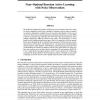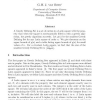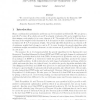DISOPT
2008
14 years 4 months ago
2008
A pseudolattice L is a poset with lattice-type binary operations. Assuming that the pseudolattice permits a modular representation as a family of subsets of a set U with certain c...
DM
2010
14 years 4 months ago
2010
The Grundy number of a graph G, denoted by (G), is the largest k such that G has a greedy k-colouring, that is a colouring with k colours obtained by applying the greedy algorithm...
CORR
2008
Springer
14 years 4 months ago
2008
Springer
Finding the largest clique in random graphs is a well known hard problem. It is known that a random graph G(n, 1/2) almost surely has a clique of size about 2 log n. A simple greed...
CORR
2010
Springer
14 years 4 months ago
2010
Springer
We tackle the fundamental problem of Bayesian active learning with noise, where we need to adaptively select from a number of expensive tests in order to identify an unknown hypot...
ARSCOM
2008
14 years 4 months ago
2008
A Greedy Defining Set is a set of entries in a Latin square with the property that when the square is systematically filled in with a greedy algorithm, the greedy algorithm succee...
AOR
2007
14 years 4 months ago
2007
We corrected proofs of two results on the greedy algorithm for the Symmetric TSP and answered a question in Gutin and Yeo, Oper. Res. Lett. 30 (2002), 97–99.
ALGORITHMICA
2010
14 years 4 months ago
2010
It is well-known that the greedy algorithm produces high quality spanners and therefore is used in several applications. However, for points in d-dimensional Euclidean space, the g...
FOCS
2008
IEEE
14 years 5 months ago
2008
IEEE
Given a universe U of n elements and a weighted collection S of m subsets of U, the universal set cover problem is to a-priori map each element u ∈ U to a set S(u) ∈ S contain...
ATAL
2010
Springer
14 years 5 months ago
2010
Springer
Service coordination in domains involving temporal constraints and duration uncertainty has previously been solved with a greedy algorithm that attempts to satisfy service requests...
IPCO
1992
14 years 5 months ago
1992
We present exact characterizations of structures on which the greedy algorithm produces optimal solutions. Our characterization, which we call matroid embeddings, complete the par...



